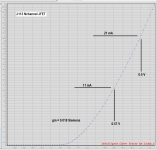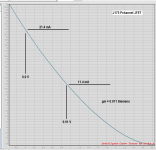Although have a look at The Art Of Electronics, 3rd edition, in section 8.6.5 Selecting low-noise JFETs
I measured some Fairchild J1xx devices over the weekend, and found that
J113, J112, J111 all have the same transconductance; where they differ is in Vpinchoff (which results in different Idss too). Probably they all use the same die layout, and get different implant doses to create different Vp's.
J109 has a higher transconductance than J111-113. Probably has a bigger die with larger (W/L) ratio of the conductive channel.
J107 has a yet-higher transconductance than J109. Probably has a yet bigger die with yet larger (W/L). J106 gm is same as J107
J105 is too macho for my curve tracer (Idss > 1 ampere!!)
[for low noise amplifiers] we favor JFETs with high transconductance and low gate-cutoff voltages, but sadly many of the old favorites with superior performance have been discontinued. NXP's BF862 has become a "go-to" low-noise part, both quiet and with attractively low capacitance. Toshiba's 2SK170 has been single-handedly kept in stock by large factory purchases by Mouser [no longer true it seems], and the second-source LSK170 is available directly from Linear Integrated Systems, who also offer a matched dual version of the venerable '170, the LSK389. The excellent IFN146 and IFN147 are available directly from InterFET. Also consider the Fairchild J107, a low-cost switch that can moonlight as a low-noise JFET amplifier; with luck it will remain available.
I measured some Fairchild J1xx devices over the weekend, and found that
J113, J112, J111 all have the same transconductance; where they differ is in Vpinchoff (which results in different Idss too). Probably they all use the same die layout, and get different implant doses to create different Vp's.
J109 has a higher transconductance than J111-113. Probably has a bigger die with larger (W/L) ratio of the conductive channel.
J107 has a yet-higher transconductance than J109. Probably has a yet bigger die with yet larger (W/L). J106 gm is same as J107
J105 is too macho for my curve tracer (Idss > 1 ampere!!)
Having gone through this exercise previously, I found that the P's and
N's of the Fairchilds are not similar enough to easily give really low
distortion as complementary parts. If you don't mind a little 2nd harmonic,
then you're OK.
Here is an example which illustrates what Nelson is talking about. This is an Idss-matched pair of Fairchild J113 + J175. Although the Idss values are the same (21.2 mA), the transconductance ("gm" == slope == dI/dV) values are NOT the same. Pew.
_
Attachments
Or build a balanced gain stage...[...]
You can tweak around with them to reduce that 2nd, but it's pretty tedious
and cumbersome. [...]
Use 3:2 and be even closer.
What I've been saying get the beta (gm parameter) to match not Idss. I tried to make this clear to the guys at Linear Systems, the first samples of J74's had low beta (gm parameter) and trying to change things to increase Idss might only increase Vp also. Last I looked they were more on the right track.
Last edited:
Here is an example which illustrates what Nelson is talking about. This is an Idss-matched pair of Fairchild J113 + J175.
More importantly the process on the P seems hopelessly noisy.
Having gone through this exercise previously, I found that the P's and
N's of the Fairchilds are not similar enough to easily give really low
distortion as complementary parts. If you don't mind a little 2nd harmonic,
then you're OK.
You can tweak around with them to reduce that 2nd, but it's pretty tedious
and cumbersome. The Toshiba/LS parts were designed as complements
for amplifiers, and so they perform better without extra effort.
The problem is that the P channel devices have a lower transconductance, so why not double up on them?
The best match I get (so far just in my simulator) is with one J113 and a pair of J177 in parallel.
The J177 is only available as smd though, if you need legs two J176 with one J113 or J112 also seem to work pretty well.
- Home
- Amplifiers
- Pass Labs
- how about using J111 J175 Jfets in F5

